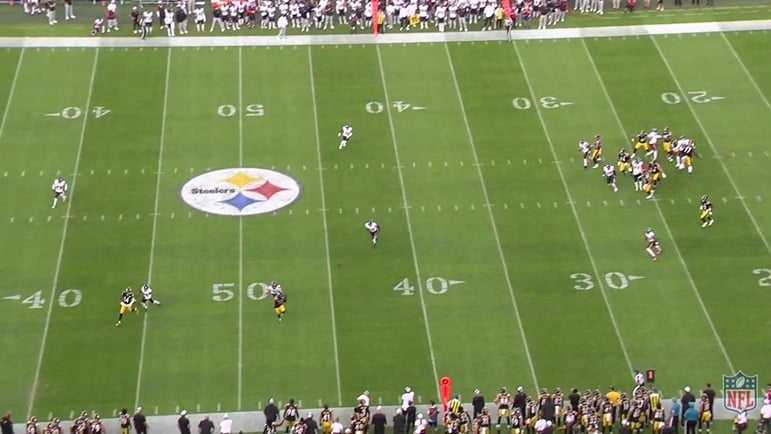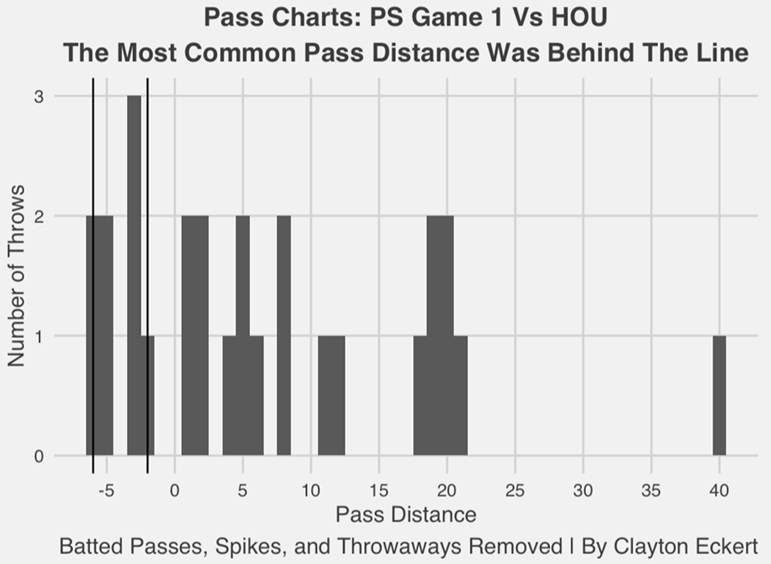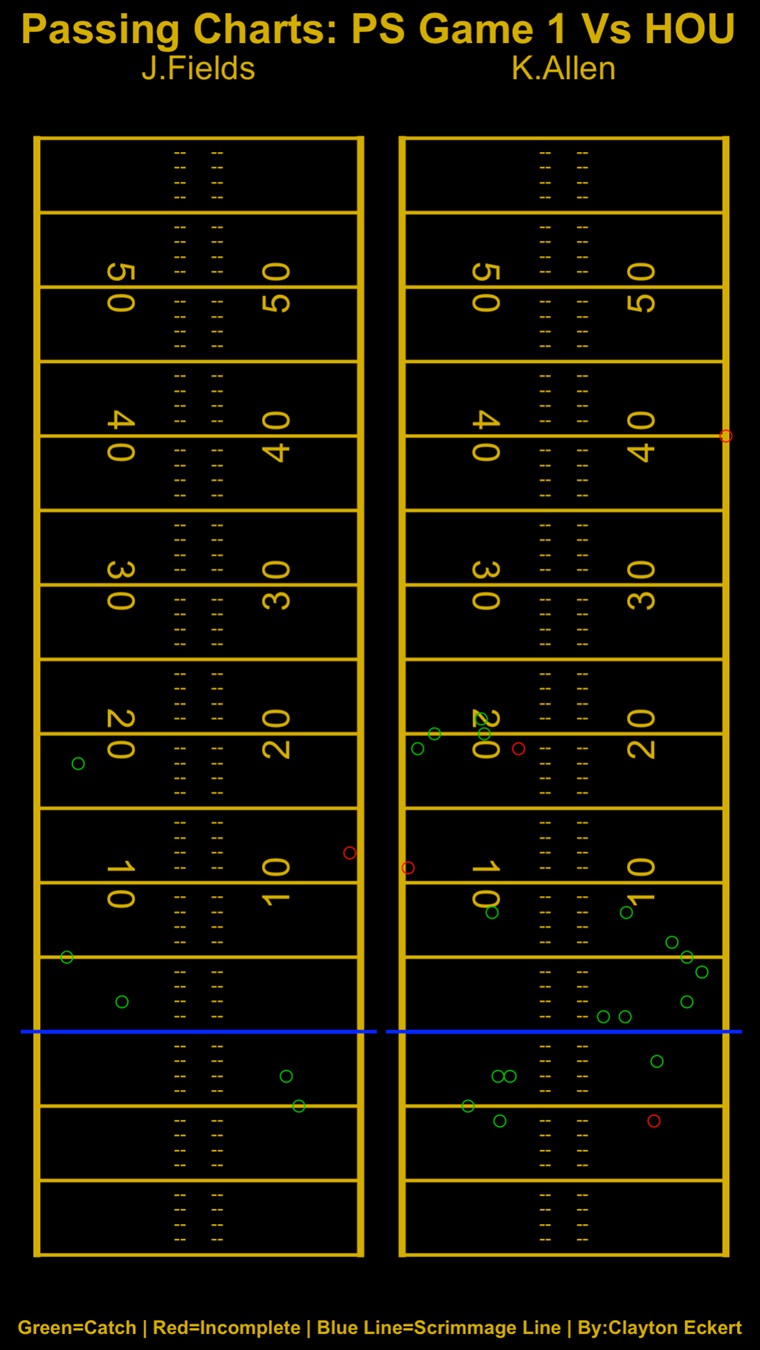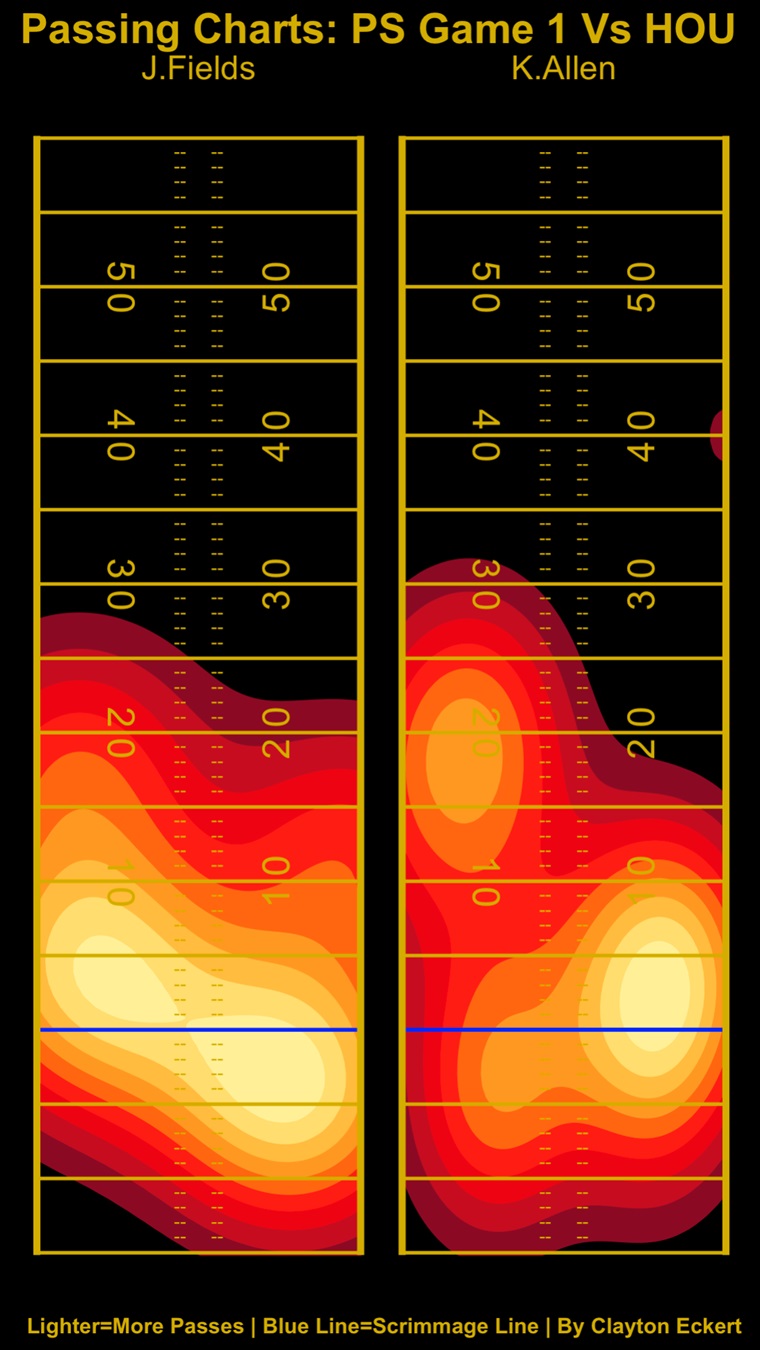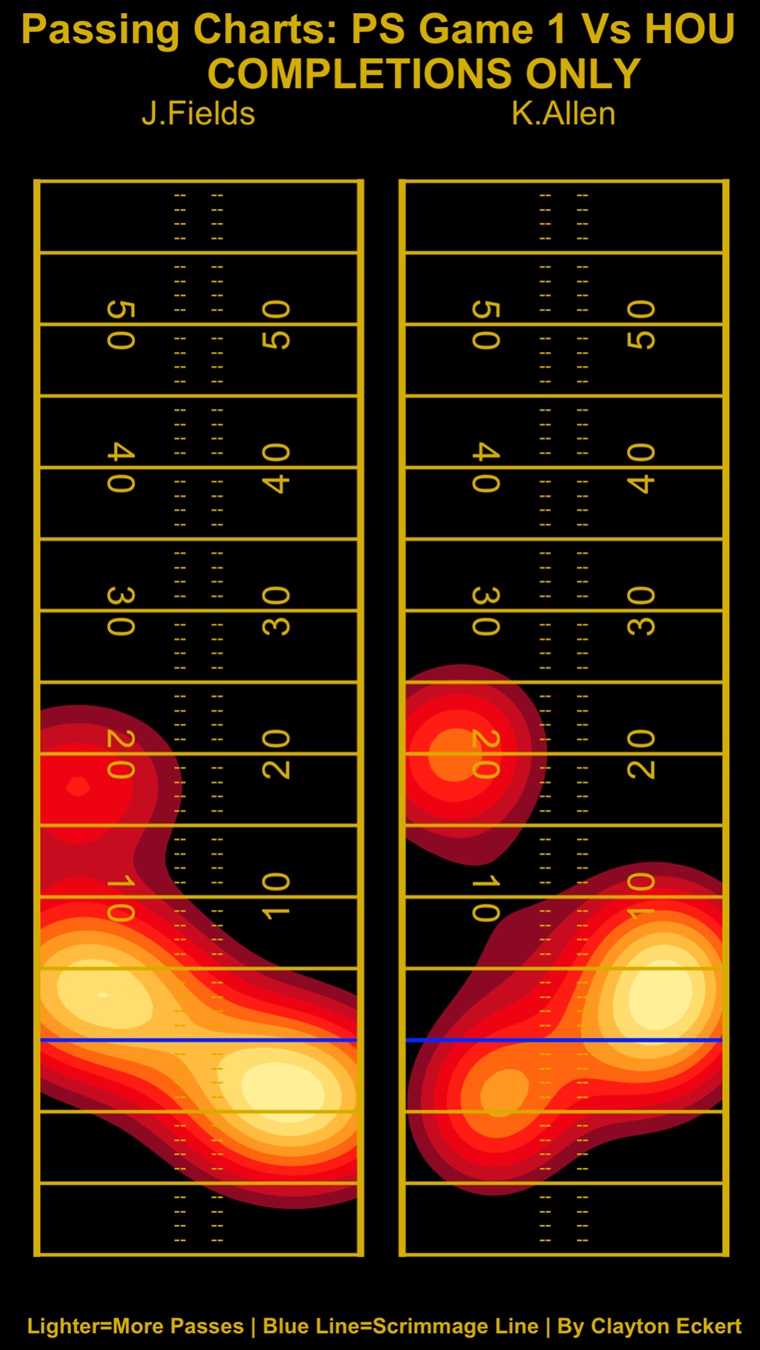The 2024 football season is finally here! For the third season now, I will be charting, visualizing, and providing takeaways for the all-important quarterback position for the Pittsburgh Steelers.
Couple of notes before we jump in. Thanks to Thomas Mock for his great work that helped me learn much of what I’m using in the series visually. Spikes and clear throwaways are removed due to being the correct situational decision, along with bats at the line of scrimmage. In this game, one throwaway and a spike were removed.
QB Justin Fields got the start with Russell Wilson not participating. As a passer, Fields went 5-of-6 (83.3-percent) for 67 yards, with no touchdowns or interceptions and a 113.2 QB rating. There were other issues though, including two botched exchanges with C Nate Herbig, taking two sacks, while he didn’t display much as a scrambler.
Kyle Allen was the only other QB to play in the opener, going 17-of-23 (73.9-percent) in the final three quarters. He tallied 193 passing yards and a red zone touchdown in the flat to TE Connor Heyward. But Allen was also sacked and threw an interception on the final throw of the game attempting a comeback in the 20-12 loss, posting a 95.0 QB rating.
Let’s look at a simple view of all 27 charted passes, with number of throws at each pass distance for the game:
#1. Behind-the-Line: 29.6-percent. Vanilla was to be expected in the preseason with behind the line passes leading the way. On these eight passes, seven were screens, six of which were to running backs. The highlight was the first pass of the game, from Fields despite a QB hit (OT Broderick Jones) to RB Najee Harris at -5 air yards, showcasing his forced missed tackle abilities for a great 16-yard gain.
One non-RB play was a sidearm screen around the rush to WR George Pickens, picking up where he left off last season with improved YAC for a ten-yard chain mover. The other was to Heyward in the flat off play-action, which we thankfully saw a heavy dose of, tackled quickly for no YAC and a loss of two. Also, Allen overthrew one badly to RB La’Mical Perine off play-action.
Overall, 5-of-8 gained positive yardage (62.5-percent), 2-of-8 were first downs (25-percent), and both third down attempts failed.
#2. 0-5 air-yards: 25.9-percent. This is typically the most common pass distance for NFL teams with seven such attempts in this one. First example was Pickens’ other target, catching the stop route at 5 air-yards, and forcing a missed tackle for 15-yards on 2nd-and-11. Starters showing YAC once again.
The next example was to TE Pat Freiermuth, a short target of 2 air-yards on 3rd-and-13, with off-coverage encouraging that Fields decision that stalled the opening drive. Next example was a 2nd-and-1 red zone attempt, running shallow crossers that freed WR Scotty Miller at the sticks, and converting on the three-yard gain.
In the third quarter, Allen hit WR Jaray Jenkins on the stop route at 5 air yards, adding another impressive YAC effort including a forced missed tackle for a nice 16-yard gain on 2nd-and-11.
Most encouraging was the aforementioned Heyward touchdown, roaming to the flat on 1st-and-goal from the six-yard line, with four yards of YAC and churning his way in four six. On the final drive, RB Daijun Edwards caught a leak-out at one air yard, forcing a missed tackle to pick up nine yards. The final example was another stop route to Jenkins, running out-of-bounds for the first down and stopping the clock.
Encouragingly, 5-of-7 plays moved the chains (71.4-percent), but the lone third down attempt failed.
T-3rd. 5-10 air-yards: 18.5-percent. Five plays here. Two came in the final minute, slant routes at 8 air yards. WR Duece Watts was the first recipient, hanging on despite a big hit. The other two WR Tarik Black on third-and-one, catching the high/behind throw from Allen plus a bit of YAC for 11 yards. Another yet to be mentioned was an out route to Miller to close the third quarter.
In total, 3-of-5 went for first downs (60-percent), and the lone third down attempt converted.
T-3rd. 15-20 air-yards: 18.5-percent. Five attempts. This deeper intermediate pass distance is something I’ve been clamoring to see more consistently, often the least common pass distance since I began my charting in 2022.
First example was off play-action, with a nice throw from Fields despite the QB hit (Herbig/Jones), hitting WR Van Jefferson on the intermediate crosser at 18 air yards and 20-yard explosive play.
The first pass of the first quarter Allen eluded pressure (T Dylan Cook), rolling to eventually find WR Calvin Austin wide-open at 19 air yards, adding a bit of YAC for another explosive gain (24 yards). Unfortunately though, the final pass of the game falls in this category, with Allen overthrowing WR Jacob Copeland over the middle for an interception, sealing the loss.
Encouragingly, 4-of-5 went for explosive plays, but the other being the interception.
#5. Explosive: 14.8-percent. Speaking of which, four passes in the opener were explosive in air yardage. Fields had none though, which will hopefully change as the preseason progresses.
For starters, Allen’s first pass in the second quarter was right at 20 air yards, standing tall in the pocket despite a free rusher off play-action and hitting the deep crosser to WR Dez Fitzpatrick, who added healthy YAC for 34 yards. Later in the quarter, Allen launched a go route for the longest air yardage of the game (40) to Miller. The latter is fast but went over his head and was nearly intercepted (out of bounds).
The next example was another nice play where Austin got wide open on a seven route, catching the 20 air yard target on 2nd-and-17, and added YAC for a 25-yard gain. To open the fourth quarter, the final example was another play-action with an awesome double-move from Miller, working outside to reel in 21 air yards and more healthy YAC on the 38-yard gain. Great catch and throw under pressure (Joey Fisher, Devery Hamilton).
In all, 3-of-4 were caught and included YAC, while the incompletion was the longest attempt at double-explosive air yards (40 or more).
#6. 10-15 air-yards: 7.4-percent. The short intermediate distance was least common by far, with just two attempts. One was Fields’ final pass, an intermediate out that was slightly behind to Jefferson, who debatably made the catch but was questionably ruled incomplete. Tomlin did not challenge.
The other was the most painful throw of the game. On 4th-and-goal from the two-yard line, Austin ran free to the corner of the end zone, but Allen overthrew the gimmie touchdown. Very unfortunate missed opportunity, with OC Arthur Smith scheming the play to perfection.
Here are the dots of completions/incompletions for the game:
Two things jump out to me. It was a conservative start with Fields, with no explosive attempts, and only two past ten yards. Secondly, no targets on or between the hashes for either quarterback. So, while I enjoyed the route concepts in Smith’s offense initially, that will be interesting to monitor moving forward.
Completion Rates By Distance:
JUSTIN FIELDS:
Behind-the-line: 2/2 (100-percent).
0-5 air-yards: 2/2 (100-percent).
5-10 air-yards: 1/1 (100-percent).
10-15 air-yards: 0/1 (0-percent).
15-20 air-yards: 1/1 (100-percent).
Explosive: 0/0 (N/A).
KYLE ALLEN:
Behind-the-line: 5/6 (83.3-percent).
0-5 air-yards: 5/5 (100-percent). Touchdown.
5-10 air-yards: 4/4 (100-percent).
10-15 air-yards: 0/1 (0-percent).
15-20 air-yards: 3/4 (75-percent). Interception.
Explosive: 1/2 (50-percent).
Completion Rates By Location:
JUSTIN FIELDS:
Outside left numbers: 2/2 (100-percent).
Left numbers-left hash: 1/1 (100-percent).
Inside hashes: 0/0 (N/A).
Right hash-right numbers: 0/0 (N/A).
Outside right numbers: 2/3 (66.7-percent).
KYLE ALLEN:
Outside left numbers: 3/4 (75-percent).
Left numbers-left hash: 6/7 (85.7-percent). Interception.
Inside hashes: 0/0 (N/A).
Right hash-right numbers: 3/3 (100-percent).
Outside right numbers: 5/7 (71.4). Touchdown.
Interesting baseline numbers. It’s just one game, and I will continue tracking and provide further takeaways as opportunities increase.
Now for the heat-maps for charted-passes, then completions only:
These heat maps will become more accurate and telling as sample sizes grow (low attempts = wider color spreads). Not overreacting, but an overarching takeaway is that things will hopefully open up more as the preseason progresses in terms of air yardage, along with the middle of the field.
I can’t wait to see how it continues to unfold for these two quarterbacks, along with others, particularly the expected starter in Wilson.

